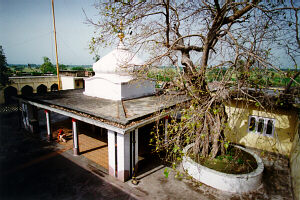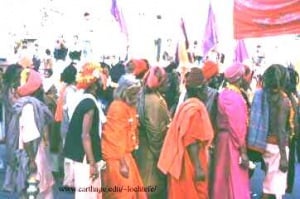Udasi Sikhs: Difference between revisions
No edit summary |
No edit summary |
||
| Line 1: | Line 1: | ||
{{NonSikhArticle}} | |||
Time of origin: 1494 (birth of Baba Siri Chand Maharaj), established as an institution in early 1600s | Time of origin: 1494 (birth of Baba Siri Chand Maharaj), established as an institution in early 1600s | ||
Revision as of 14:10, 24 July 2007
| This article may contain Sects or Cults, Fake Babas, Deras, Fake Nihangs, Sanatan Dharmis, Pseudo Akalis & Mahants, Pseudo Intellectuals & Historians, Leftists and agnostic which are not considered a part of Sikhism. The article is just for information purposes.
Please do not amended this article. If you have any comments, please discuss them here |
Time of origin: 1494 (birth of Baba Siri Chand Maharaj), established as an institution in early 1600s
Doctrines
Udasis are usually celibate and renounce worldly cares, but still regard themselves as Sikhs. Anand Ghan (see below) believed that Baba Sri Chand was an incarnation of God, and the only successor of Guru Nanak. Ghan also believed in many Brahmanical-cum-Hindu ideas that the Sikh Gurus did not advocate. These included the theory of the incarnation of God, Brahmanic rituals and practices and the belief in the necessity of renunciation, the practice of austerities, asceticism and celibacy, though most cut their hair. These largely Vedantic, philosophical beliefs led them away from Bhakti (loving devotion of the divine) to a knowledge and meditation of the divine, such that there was a shift from a personal God to an impersonal reality. Although they believe in the Adi Granth and pay it great respect, they do not believe in the householder (grihasti) of the Gurus, nor the doctrines of Guru Panth and Guru Granth, nor in the accumulation of wealth and property. Furthermore Guru Nanak's definition of 'udas' was "to make use of all things in this world and not deem them one's own, but only God's property, and ever to possess a desire to meet Him in udas". (See Foundation, Evolution and Transformation of the Sikh Panth entries).
History
The Udasis were founded by Baba Sri Chand (1494-1629), the eldest son of Guru Nanak. Udasi, from the root 'udas' means detachment, withdrawal from worldly life, solitary, sadness and grief, and so refers to one who renounces. Traditionally he is said to have opposed his father's appointment of Guru Angad as the second Guru, and so he started his own order. He lived a celibate life of renunciation and asceticism. During the seventeenth century the Udasis grew in number and were respected by the early Sikh Panth. Early Sikh records show that there were ten major Udasi orders.
During eighteenth century, the Udasis (not appearing as Khalsa Singhs) escaped the persecution of the Mughal rulers. Since they considered themselves as Sikhs, this naturally led them to look after the Sikh shrines in the absence of Khalsa Singhs and the Akalis/Nihangs (see separate entries). Here they performed a key role in keeping Sikh teaching alive. Anand Ghan, an Udasi scholar of the late 18th and early 19th centuries, wrote commentaries on the Adi Granth from a largely Hindu-Vedantic perspective.
The Mahants (those in charge of the Gurdwaras) of the nineteenth and early twentieth century, frequently claimed an Udasi descent, though their life style had considerably changed. The crucial juncture in Udasi history came in 1921 when a Mahant of Nanakana Sahib Gurdwara, claiming to be an Udasi, orchestrated the massacre of a large group of Akalis (see separate entry) who were seeking non-violently to reclaim the temple. Today they are seen as Sahajdhari or Sanatan Sikhs as opposed to Khalsa Singhs (see respective entries).

Symbols
No distinct restrictions on hair; some wore it long and matted, others short. The matted hair symbolises their renunciation of worldly life. To this extent many go around naked and smear ash on their bodies, again symbolising their death to the world of family relations business and caste.
Adherents
There were more than a dozen orders at the end of Sikh Rule in 1849. The number of establishments rose dramatically from the 1790s to the 1840s. They had more than 250 centres (akharas) spread across the Panjab and even beyond. In the 1891 Census 10,518 Hindus and 1,165 Sikhs returned themselves as 'Udasis'. (Census of India, 1891, Vol.XX and Vol.XXI, The Punjab and its Feudatories, by E.D. Maclagan, Part II and III, Calcutta, 1892, pp.826-9 and pp.572-3.) However, there are no official contemporary numbers, (see also the note at the end of the Explanatory Introduction).
Headquarters/Main Centre
There were four Udasi centres (akharas or dhuans) each controlling certain preaching areas. These were eastern India (with the main centre at Nanakmata), western Panjab and Kashmir, Malwa and Doaba.
Brief Description
The Udasi sampradaya (tradition) was founded by Baba Sri Chand Ji Maharaj, the elder son, and sikh (disciple) of Sri Sadguru Nanak Dev Ji. Its adherents not only revere Sri Guru Granth Sahib, but have in their treasure-house of sacred texts, Sanskritic scriptures such as the Veda, the Shastras, the Puranas, the Itihasas viz. the Ramayana and the Mahabharata, etc., along with works associated with the Gurus. To Udasis, also known as Nanak-putras (sons of Nanak), Guru Nanak Dev Ji is none other than the avatar of Sri Vishnu, and Baba Sri Chand Ji of Bhagavan Shiva. While the purpose of both was to protect the sanatan or eternal Dharma (moral and cosmic Order), the particular mission of Baba Ji was to spread the message of his Guru and father, Nirankar-svarup (the form of the Formless) Jagadguru Nanak Dev Ji. Thus, in the spirit of their founder, the scholarly Udasis were the missionaries of Gurmat.
The Udasis engage in pancadevopasana, the worship of a combination of five deities or the five qualified facets of the Brahman, namely Shiva, Vishnu, Surya, Durga, and Ganesh, and their philosophy is that of monistic or advaita Vedanta as popularised by Adi Sankaracarya. Amongst Udasis, some are celibate ascetics, others householders, some are jatadhari (dreadlocked) ash-covered Sadhus, and others have no distinctive appearance. Not only are they scholars of Sanskrit, their particularly adept in Ayurveda, the tradition Indian medicine. When the Khalsa Singhs were involved in war against the Mughals, it was the Udasis that kept the Guru’s tradition alive by becoming custodians of the Gurdwaras.
Given some of the beliefs and practices above, one may wonder who the Udasis are and whether they are confused. There are three possibilities of explanation: 1. either they do not know whether they follow ‘Hindu-ism’ or ‘Sikh-ism’, or 2. they have taken parts of both, or 3. it is in fact the world who is mistakenly confused by seeing things in black and white and it is the Udasis who, amongst other legitimate sampradayas going back to the Gurus, truly follow and understand the teachings of the Great Sovereign Masters. It is not they who have problems of identity, but everyone else.
Their reality depicts a diminishing truth, while the rest of the modernist world has been unknowingly duped into the duality of these two artificial and until recently, non-existent religious categories viz. ‘Hindu-ism’ and ‘Sikh-ism’ created by British Colonialists. This is not how it used to be. After all the suffix ism which is the crux of our problem of understanding the truth as it stood before the time of the Raj, conceptually and linguistically belongs to the Western world, and is alien to the traditional Indian mind. To understand the reality of religiosity before the intellectual impact of the British Raj in Panjab, and thus the world of the Udasis and other puratan (ancient) traditions, one must understand it from its own perspective, not from the foreign concepts and categories of western thought.
References
www.udasi.org
Checked
No copyright with sarabhloh.info.....................user:paapi
| Sects & Cults |
|
♣♣ Ad Dharm ♣♣ Akalis ♣♣ Bandai Sikhs ♣♣ Balmiki ♣♣ Bhatra ♣♣ Brindaban Matt ♣♣ Daya Singh Samparda ♣♣ Dhir Malias ♣♣ Handalis ♣♣ Kabir Panthi ♣♣ Kirtan jatha Group ♣♣ Kooka ♣♣ Kutta Marg ♣♣ Majhabi ♣♣ Manjis ♣♣ Masand ♣♣ Merhbanieh ♣♣ Mihan Sahibs ♣♣ Minas ♣♣ Nirankari ♣♣ Nanak panthi ♣♣ Nanakpanthi Sindhis ♣♣ Namdev Panthi ♣♣ Namdhari ♣♣ Nanaksaria ♣♣ Nihang ♣♣ Nikalsaini ♣♣ Niranjaniye ♣♣ Nirmala ♣♣ Panch Khalsa Diwan ♣♣ Parsadi Sikhs ♣♣ Phul Sahib dhuan ♣♣ Radha Swami ♣♣ Ram Raiyas ♣♣ Ravidasi ♣♣ Ridváni Sikhs ♣♣ Suthra Shahi ♣♣ Sewapanthi ♣♣ Sat kartaria ♣♣ Sant Nirankaris ♣♣ Sanwal Shahis ♣♣ Sanatan Singh Sabhais ♣♣ Sachkhand Nanak Dhaam ♣♣ Samparda Bhindra ♣♣ Tat Khalsa ♣♣ Sikligars ♣♣ Pachhada Jats ♣♣ Satnami's ♣♣ Udasi Sikhs ♣♣ |

